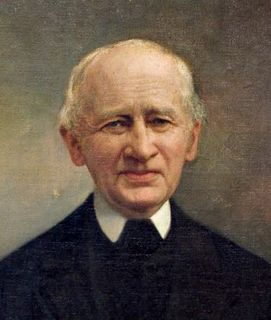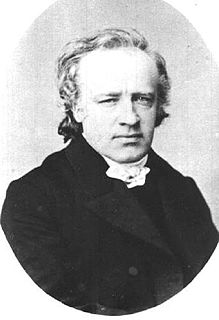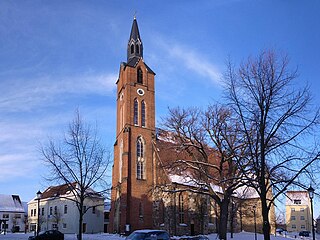
Paul Gerhardt was a German theologian, Lutheran minister and hymnodist.

Johann Gottfried Galle was a German astronomer from Radis, Germany, at the Berlin Observatory who, on 23 September 1846, with the assistance of student Heinrich Louis d'Arrest, was the first person to view the planet Neptune and know what he was looking at. Urbain Le Verrier had predicted the existence and position of Neptune, and sent the coordinates to Galle, asking him to verify. Galle found Neptune in the same night he received Le Verrier's letter, within 1° of the predicted position. The discovery of Neptune is widely regarded as a dramatic validation of celestial mechanics, and is one of the most remarkable moments of 19th-century science.
Wittenberg is a district in the east of Saxony-Anhalt, Germany. Neighboring districts are Anhalt-Bitterfeld, the district-free city of Dessau-Roßlau, the districts of Potsdam-Mittelmark, Teltow-Fläming and Elbe-Elster in Brandenburg, and the district of Nordsachsen in the Free State of Saxony. Capital and largest city is Wittenberg, a UNESCO world heritage.

Heinrich Louis d'Arrest was a German astronomer, born in Berlin. His name is sometimes given as Heinrich Ludwig d'Arrest.

The Berlin Observatory is a German astronomical institution with a series of observatories and related organizations in and around the city of Berlin in Germany, starting from the 18th century. It has its origins in 1700 when Gottfried Leibniz initiated the "Brandenburg Society of Science″ which would later (1744) become the Prussian Academy of Sciences. The Society had no observatory but nevertheless an astronomer, Gottfried Kirch, who observed from a private observatory in Berlin. A first small observatory was furnished in 1711, financing itself by calendrical computations.

Galle is a crater on Mars. It is located on the eastern rim of the huge impact basin Argyre Planitia in Argyre quadrangle. It is named after the German astronomer Johann Gottfried Galle. Galle is often known as the "happy face crater" because pareidolia causes a curved mountain range in the southern part of the crater and two smaller mountain clusters further north to appear to be a smiley face. The formation was first photographed by Viking Orbiter 1.

Gräfenhainichen (help·info) is a town in Wittenberg district in Saxony-Anhalt, Germany.
Jüdenberg is a community in Wittenberg district in Saxony-Anhalt, Germany. Since January 2007, it belongs to the municipality of Gräfenhainichen. Jüdenberg lies about 4 km northwest of Gräfenhainichen on the edge of the Biosphere Reserve Middle Elbe.

Kemberg is a town in Wittenberg district in Saxony-Anhalt, Germany. The town lies on the north edge of the Düben Heath Nature Park.
Möhlau is a village and a former municipality in Wittenberg district in Saxony-Anhalt, Germany. Since 1 January 2011, it is part of the town Gräfenhainichen. It was part of the administrative community (Verwaltungsgemeinschaft) of Tor zur Dübener Heide.
Schköna is a village and a former municipality in Wittenberg district in Saxony-Anhalt, Germany. Since January 1, 2011, it is part of the town Gräfenhainichen. It was part of the administrative community (Verwaltungsgemeinschaft) of Tor zur Dübener Heide since January 1, 2005.
Schleesen is a village and a former municipality in Wittenberg district in Saxony-Anhalt, Germany. Since 1 January 2010, it is part of the town Kemberg.

Selbitz is a village and a former municipality in Wittenberg district in Saxony-Anhalt, Germany. Since 1 January 2010, it is part of the town Kemberg.
Söllichau is a village and a former municipality in Wittenberg district in Saxony-Anhalt, Germany. Since 1 July 2009, it is part of the town Bad Schmiedeberg. It is situated between the small towns of Bad Düben and Bad Schmiedeberg, in the middle of the Düben Heath. The former municipality had one constituent centre, die Gleinermühle.
Tornau is a village and a former municipality in Wittenberg district in Saxony-Anhalt, Germany. Since 1 January 2011, it is part of the town Gräfenhainichen. It was part of the administrative community (Verwaltungsgemeinschaft) of Tor zur Dübener Heide.
Uthausen is a village and a former municipality in Wittenberg district in Saxony-Anhalt, Germany. Since 1 January 2010, it is part of the town Kemberg.

Zschornewitz is a village and a former municipality on the southwestern edge of the Wittenberg district in Saxony-Anhalt, Germany. Since 1 January 2011, it is part of the town Gräfenhainichen. It was part of the administrative community (Verwaltungsgemeinschaft) of Tor zur Dübener Heide. It lies about 4 km west of the former district seat of Gräfenhainichen, right on the border with Saxony.

Schneeberg is a town in Saxony’s district of Erzgebirgskreis. It has roughly 16,400 inhabitants and belongs to the Town League of Silberberg. It lies 4 km west of Aue, and 17 kilometres (11 mi) southeast of Zwickau.

The Düben Heath is a landscape in Germany in eastern Saxony-Anhalt and northern Saxony, between the rivers Elbe and the Mulde, on the northern edge of the Leipzig Bay.
Galle is a surname. Notable people with the surname include:













